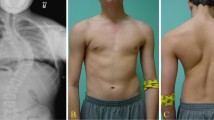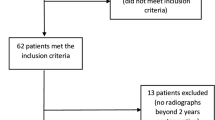Abstract
Introduction
Incidences of scapular notching (SN) in reverse shoulder arthroplasty (RSA) range between 0% and 96%, and controversy remain as to its relevance for patient outcome. We assessed the reliability of scapular notching (SN) grading based on the Sirveaux classification system using anteroposterior radiographs.
Materials and methods
206 RSA procedures with 5-year postoperative anteroposterior shoulder radiographs were classified independently by seven assessors according to Sirveaux (session 1). After a review meeting, three assessors re-classified the radiographs along with quality criteria (session 2). SN grading by the majority of assessors was taken as the reference. Classification interobserver reliability was analyzed using Kappa statistics.
Results
The incidence of SN was estimated at 53% and 37% at the first and second sessions, respectively. Interobserver reliability Kappa coefficients resulting from the first and second sessions were 0.27 and 0.43, respectively. Case selection based on radiographic quality criteria did not improve SN grading reliability in the second session.
Conclusion
Agreement between individual surgeons was low when grading SN in RSA according to Sirveaux using anteroposterior radiographs. Consensus among several assessors may increase reliability in research settings.





Similar content being viewed by others
References
Boileau P, Watkinson D, Hatzidakis AM, Hovorka I (2006) Neer Award 2005: the Grammont reverse shoulder prosthesis: results in cuff tear arthritis, fracture sequelae, and revision arthroplasty. J Shoulder Elb Surg 15:527–540. https://doi.org/10.1016/j.jse.2006.01.003
Boulahia A, Edwards TB, Walch G, Baratta RV (2002) Early results of a reverse design prosthesis in the treatment of arthritis of the shoulder in elderly patients with a large rotator cuff tear. Orthopedics 25:129–133. https://doi.org/10.3928/0147-7447-20020201-16
De Wilde L, Mombert M, Van Petegem P, Verdonk R (2001) Revision of shoulder replacement with a reversed shoulder prosthesis (Delta III): report of five cases. Acta Orthop Belg 67:348–353
Guery J, Favard L, Sirveaux F, Oudet D, Molé D, Walch G (2006) Reverse total shoulder arthroplasty. Survivorship analysis of eighty replacements followed for five to ten years. J Bone Jt Surg Am 88:1742–1747. https://doi.org/10.2106/JBJS.E.00851
Kempton LB, Balasubramaniam M, Ankerson E, Wiater JM (2011) A radiographic analysis of the effects of glenosphere position on scapular notching following reverse total shoulder arthroplasty. J Shoulder Elb Surg 20:968–974. https://doi.org/10.1016/j.jse.2010.11.026
Kowalsky MS, Galatz LM, Shia DS, Steger-May K, Keener JD (2012) The relationship between scapular notching and reverse shoulder arthroplasty prosthesis design. J Shoulder Elb Surg 21:1430–1441. https://doi.org/10.1016/j.jse.2011.08.051
Lévigne C, Garret J, Boileau P, Alami G, Favard L, Walch G (2011) Scapular notching in reverse shoulder arthroplasty: is it important to avoid it and how? Clin Orthop Relat Res 469:2512–2520. https://doi.org/10.1007/s11999-010-1695-8
Nicholson GP, Strauss EJ, Sherman SL (2011) Scapular notching: recognition and strategies to minimize clinical impact. Clin Orthop Relat Res 469:2521–2530. https://doi.org/10.1007/s11999-010-1720-y
Sirveaux F, Favard L, Oudet D, Huquet D, Walch G, Molé D (2004) Grammont inverted total shoulder arthroplasty in the treatment of glenohumeral osteoarthritis with massive rupture of the cuff. Results of a multicentre study of 80 shoulders. J Bone Jt Surg Br 86:388–395. https://doi.org/10.1302/0301-620X.86B3.14024
McFarland EG, Sanguanjit P, Tasaki A, Keyurapan E, Fishman EK, Fayad LM (2006) The reverse shoulder prosthesis: a review of imaging features and complications. Skeletal Radiol 35:488–496. https://doi.org/10.1007/s00256-006-0109-1
Holschen M, Franetzki B, Witt KA, Liem D, Steinbeck J (2017) Conversions from anatomic shoulder replacements to reverse total shoulder arthroplasty: do the indications for initial surgery influence the clinical outcome after revision surgery? Arch Orthop Trauma Surg 137:167–172. https://doi.org/10.1007/s00402-016-2595-5
Jonušas J, Banytė R, Ryliškis S (2017) Clinical and radiological outcomes after reverse shoulder arthroplasty with less medialized endoprosthesis after mean follow-up time of 45 months. Arch Orthop Trauma Surg 137:1201–1205. https://doi.org/10.1007/s00402-017-2751-6
Simovitch RW, Zumstein MA, Lohri E, Helmy N, Gerber C (2007) Predictors of scapular notching in patients managed with the Delta III reverse total shoulder replacement. J Bone Jt Surg Am 89:588–600. https://doi.org/10.2106/JBJS.F.00226
Werner CM, Steinmann PA, Gilbart M, Gerber C (2005) Treatment of painful pseudoparesis due to irreparable rotator cuff dysfunction with the Delta III reverse-ball-and-socket total shoulder prosthesis. J Bone Jt Surg Am 87:1476–1486. https://doi.org/10.2106/JBJS.D.02342
Wierks C, Skolasky RL, Ji JH, McFarland EG (2009) Reverse total shoulder replacement: intraoperative and early postoperative complications. Clin Orthop Relat Res 467:225–234. https://doi.org/10.1007/s11999-008-0406-1
Favard L, Lévigne C, Nerot C, Gerber C, De Wilde L, Molé D (2011) Reverse prostheses in arthropathies with cuff tear: are survivorship and function maintained over time? Clin Orthop Relat Res 469:2469–2475. https://doi.org/10.1007/s11999-011-1833-y
Lévigne C, Boileau P, Favard L, Garaud P, Mole D, Sirveaux F et al (2008) Scapular notching in reverse shoulder arthroplasty. J Shoulder Elb Surg 17:925–935. https://doi.org/10.1016/j.jse.2008.02.010
Valenti PH, Bouttens D, Nerot C (2001) Delta 3 reversed prosthesis for osteoarthritis with massive rotator cuff tear, long term results (> 5 years). In: Walch G, Boileau P, Molé D (eds) 2000 shoulder prostheses. Two to ten year follow-up. Sauramps Medical, Montpellier, pp 253–259
Sadoghi P, Leithner A, Vavken P, Holzer A, Hochreiter J, Weber G et al (2011) Infraglenoidal scapular notching in reverse total shoulder replacement: a prospective series of 60 cases and systematic review of the literature. BMC Musculoskelet Disord 12:101. https://doi.org/10.1186/1471-2474-12-101
Constant CR, Gerber C, Emery RJ, Sojbjerg JO, Gohlke F, Boileau P (2008) A review of the Constant score: modifications and guidelines for its use. J Shoulder Elb Surg 17:355–361. https://doi.org/10.1016/j.jse.2007.06.022
Angst F, Goldhahn J, Pap G, Mannion AF, Roach KE, Siebertz D et al (2007) Cross-cultural adaptation, reliability and validity of the German Shoulder Pain and Disability Index (SPADI). Rheumatology 46:87–92. https://doi.org/10.1093/rheumatology/kel040
Kottner J, Audigé L, Brorson S, Donner A, Gajewski BJ, Hróbjartsson A et al (2011) Guidelines for reporting reliability and agreement studies (GRRAS) were proposed. J Clin Epidemiol 64:96–106. https://doi.org/10.1016/j.jclinepi.2010.03.002 (Blinded for review purposes)
Landis JR, Koch GG (1977) The measurement of observer agreement for categorical data. Biometrics 33:159–174
Erickson BJ, Frank RM, Harris JD, Mall N, Romeo AA (2015) The influence of humeral head inclination in reverse total shoulder arthroplasty: a systematic review. J Shoulder Elb Surg 24:988–993. https://doi.org/10.1016/j.jse.2015.01.001
Wall B, Nove-Josserand L, O’Connor DP, Edwards TB, Walch G (2007) Reverse total shoulder arthroplasty: a review of results according to etiology. J Bone Jt Surg Am 89:1476–1485. https://doi.org/10.2106/JBJS.F.00666
Wellmann M, Struck M, Pastor MF, Gettmann A, Windhagen H, Smith T (2013) Short and midterm results of reverse shoulder arthroplasty according to the preoperative etiology. Arch Orthop Trauma Surg 133:463–471. https://doi.org/10.1007/s00402-013-1688-7
Audigé L, Bhandari M, Hanson B, Kellam J (2005) A concept for the validation of fracture classifications. J Orthop Trauma 19:404–409. https://doi.org/10.1097/01.bot.0000155310.04886.37 (Blinded for review purposes)
McHugh ML (2012) Interrater reliability: the kappa statistic. Biochem Med (Zagreb) 22:276–282. https://doi.org/10.11613/BM.2012.031
Acknowledgements
The authors thank M. Wilhelmi, Ph.D., medical writer at Schulthess Clinic, for manuscript preparation and editing.
Funding
Support for this research was provided by Schulthess Clinic.
Author information
Authors and Affiliations
Corresponding author
Ethics declarations
Conflict of interest
On behalf of all authors, the corresponding author states that there is no conflict of interest.
Ethical approval
The study was performed in accordance with the ethical standards of the cantonal ethics committee of Zurich (KEK-ZH) and with the 1964 Helsinki declaration and its later amendments or comparable ethical standards. Approval for analyses of the local clinical register (KEK-ZH Nr. 2014-0483: Clinical and subjective long-term outcome after an implantation of a shoulder arthroplasty) was granted on 23.01.2015.
Rights and permissions
About this article
Cite this article
Schneider, M.M., Toft, F., Kolling, C. et al. Limited reliability of grading scapular notching according to Nerot–Sirveaux on anteroposterior radiographs. Arch Orthop Trauma Surg 139, 7–13 (2019). https://doi.org/10.1007/s00402-018-3027-5
Received:
Published:
Issue Date:
DOI: https://doi.org/10.1007/s00402-018-3027-5




